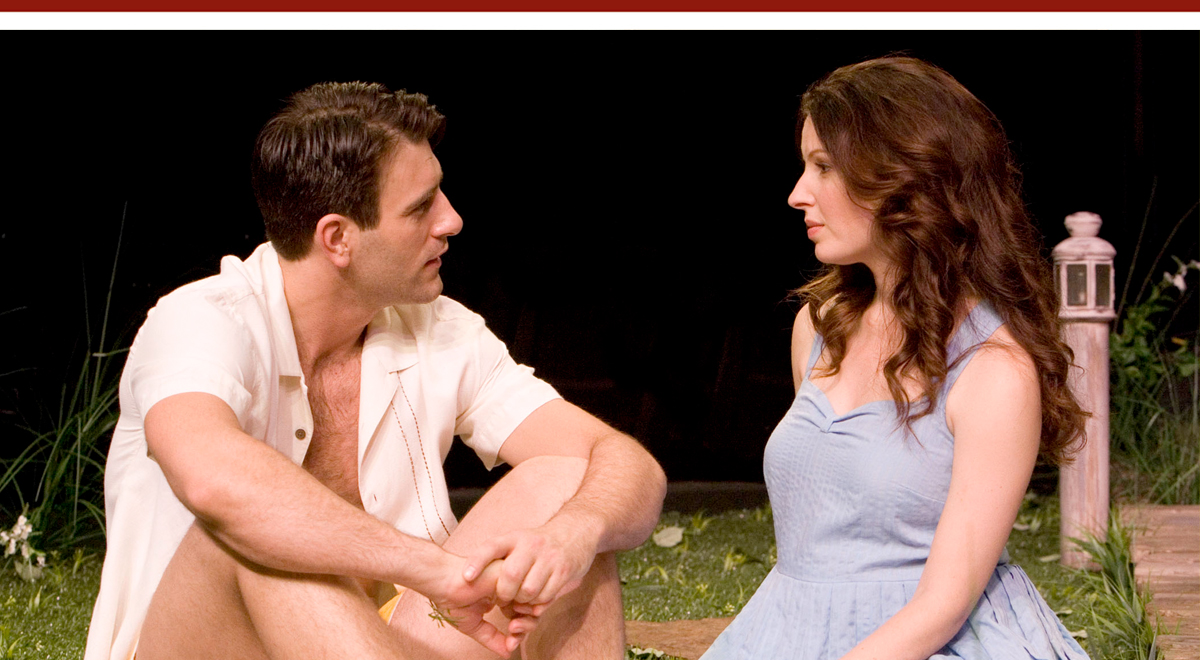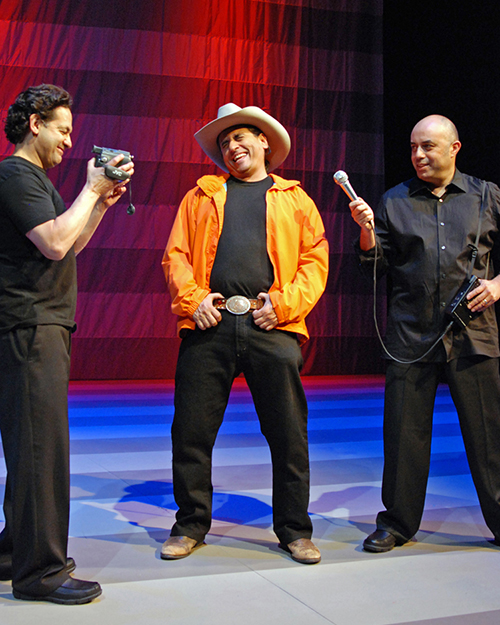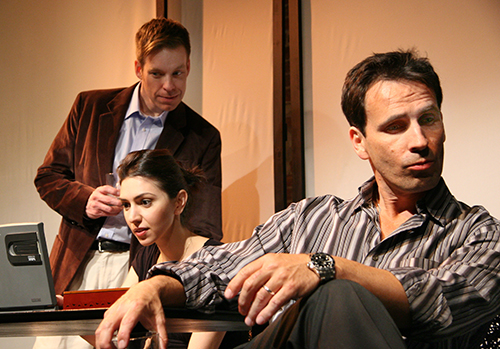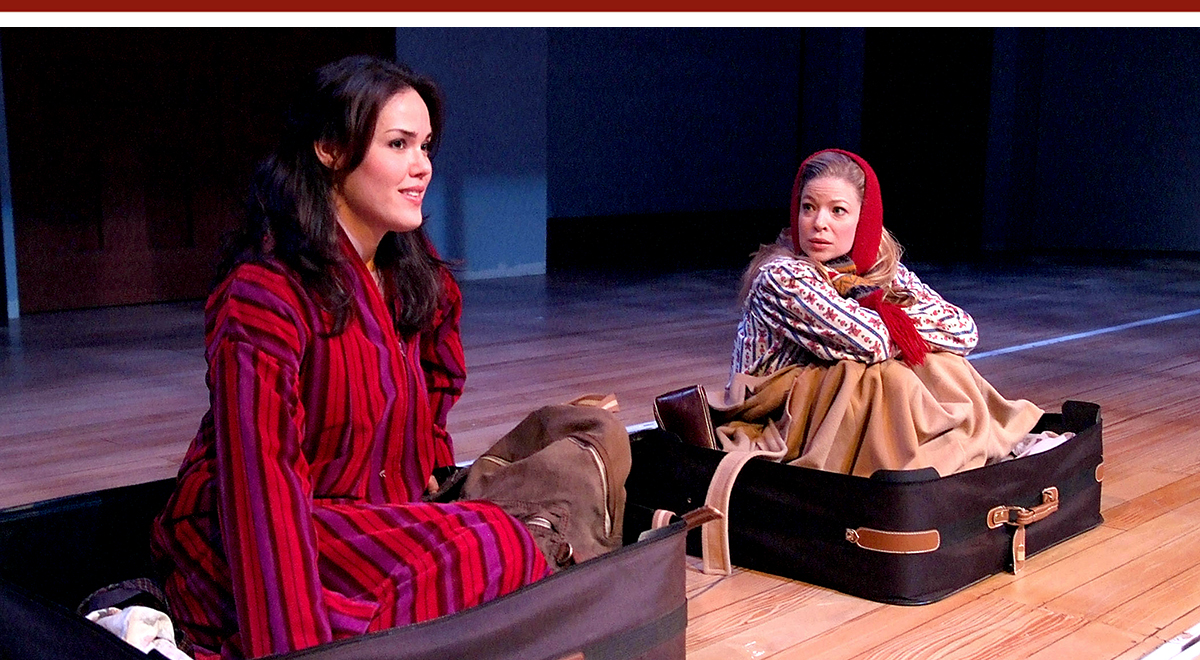MARCH 2008
Click title to jump to review
THE AMERICAN PLAN by Richard Greenberg | The Old Globe
BROWNSTONE by Catherine Butterfield | Laguna Playhouse
CULTURE CLASH IN AMERICCA by Culture Clash | South Coast Repertory
THE DYING GAUL by Craig Lucas | Elephant Theatre
HENRY IV, PT 1 by William Shakespeare | A Noise Within
MASK by Anna Hamilton Phelan, Barry Mann and Cynthia Weill | Pasadena Playhouse
NO CHILD by Nilaja Sun | Kirk Douglas Theatre
SWEENEY TODD THE DEMON BARBER OF FLEET STREET by Stephen Sondheim and Hugh Wheeler | Ahmanson Theatre

Styx, sound, moats, boats
With allusions to the divisive waterways of both Paradise Lost and The Great Gatsby, Richard Greenberg has created his own literature about how isolated people misuse love to escape their melancholy in The American Plan, a 1990 drama only now receiving its West Coast premiere. Wrapping her balanced staging around the haunting central performance of Kate Arrington, director Kim Rubenstein lets the play’s impressionistic portrait of characters at sea resonate.
Greenberg sets the American play beside a lake in the Catskill Mountains, across from a resort hotel offering affordable week-stays packaged under names like ‘The American Plan.’ It’s 1960, four decades after Adolph Hitler’s Nazi Party began setting German Jews adrift with platform points like "No Jew, therefore, may be a member of the nation," and 12 years after the founding of the nation of Israel. A flat square of grass covers the Cassius Carter’s stage floor, diagonally bisected by a wooden walk that points to the distant hotel at one corner and, in the opposite direction, to the residence of Eva Adler (Sandra Shipley), her daughter Lili (Arrington), and Olivia (Sharon Hope), the maid who has earned membership in the family.
The lake intrudes somewhat into the set, with enough depth to allow Nick Lockridge (Patrick Zeller) to rise out of the water for his sly first entrance. Lockridge, whose name not only recalls Fitzgerald’s writer-narrator but also evokes the terra firma that Lili will see in him, is a minimally successful writer staying at the hotel. The set’s seating is provided by a neglected rowboat and some iron lawn furniture. (Wilson Chin designed and Chris Rynne lighted the playing area, which adds another page to the Old Globe’s textbook illustration of how to create environments without benefit of a single vertical surface.)
The Adler house is odd in ways Greenberg is careful not to specify. Whether it has the appearance of a museum, mausoleum or boathouse, Lockridge and Gil Harbison (Michael Kirby), another intruder from the other side, are both surprised to find that people live in it.
Rubenstein, whose listed credits run towards larger productions, most recently as Associate Artistic Director at Long Wharf Theatre, shows that she is equally comfortable in a chamber size staging. She has a gift in Arrington, who seems to intuit moment-to-moment exactly when her character is showboating and when she’s sinking. For the highly intelligent and damaged Lili, the hindrances to fulfillment are different than the WASPs who partied between the World Wars in Gatsby. The Adlers are Jewish. Eva escaped "by boat" but has made her daughter an heiress to effects of that evil.
Lili has become an individual island within a family island within the ethnic island that represents the Jews in post-War America. Her final listless encounter with the out-reaching Nick exhibits only vague remainders of what might have been self and strength. The loss feels complete when we learn, in a nicely buried aside, that she is devoid of independence from her mother’s sense of furnishings, even after Eva has died.
The role of Eva provides great dramatic opportunity as far as it goes, and Shipley does well pawing, clawing and pouncing through the dominatrix’ cat-and-mouse games with the other characters. However, here we need more definition than Greenberg’s impressionistic style provides. Eva’s complexities, and her murky relationship with her late husband, need a little more bricks and mortar to help us see where she’s coming from. Filling in the blanks with "The Holocaust" is too nebulous and too easy. There is more at work here. Greenberg’s discomfort with supplying this material is evident in a scene at the top of Act II, an uncharacteristically clunky bit of exposed exposition about Lili’s father that does more to stop the storytelling than illuminate it.
Greenberg has great affection and affinity for words, and character names like Nick and Lili can justifiably recall writer Nick and troubled Daisy of that earlier masterpiece. There, of course, the concern was achieving the American Dream (or perhaps demystifying it so it wasn’t so seductive). Here, the American Plan is less oppressive, more diffuse. It is a state of freedom, from persecution (as Eva has sought), from convention (as Gil proposes in his pursuit of love), and from self-destruction (as Lili vainly hopes).
Zeller, Shaw and Kirby meet the demands of their roles without going overboard. Kirby, another of the Old Globe’s UCSD Masters students, does well in what appears a featured role debut. However, a few more outings will strengthen a performance quality that is already very promising.
In some ways, The American Plan is the American play: a statement for a larger canvas in which Greenberg offers a shadow world complement to Fitzgerald’s seminal portrait of blind American ambition torpedoed by fraud. Here, at the dawn of the 1960s when prosperity seemed within reach of anyone willing to dive in and go for it, old wounds and generational protectionism were weights that would not be ignored. Not dealing with demons only meant that any effort to make it to "the other side" opened one up to being grabbed by the darkness and pulled under.
top of page
THE AMERICAN PLAN
by RICHARD GREENBERG
directed by KIM RUBENSTEIN
OLD GLOBE THEATRE
February 23-March 30, 2008
(Cassius Carter, Opened 3/8, rev’d 3/16)
CAST Kate Arrington, Sharon Hope, Michael Kirby, Sandra Shipley, Patrick Zeller
PRODUCTION Wilson Chin, set; Emily Pepper, costumes; Chris Rynne, lights; Paul Peterson, sound, Leila Knox, stage management<
Patrick Zeller and Kate Arrington
Craig Schwartz
Three-story walk-up
A fine cast, all making Laguna Playhouse debuts, has opened Catherine Butterfield’s Brownstone in a welcome world premiere, here through April 27. Playwright Butterfield, who also directs, shows she knows her way around casting and staging as well as writing. She mines the full range of this enjoyable entertainment, which braids together three overlapping stories all set in the same New York apartment: at the end of the 1930s, the end of the 1970s and the beginning of this decade. Though individually only one of the stories really captivates, their gradually exposed weave is engaging, especially with this capable and invested ensemble.
Butterfield lets her storyline unreel without ever tipping her hand early or clumsily. Exposition is neatly half-buried and her themes are allowed to surface gradually. She shows the subtle distinctions between our airy dreams and more practical ambitions through six characters and whether or not they are "grounded." However, in the four women, who reflect the positive changes made over the 60-plus years represented by the play, we see the continuing threat to their independence, first by their fathers, and then by their children’s fathers. There is also a reminder that a catastrophe of the most intimate nature can damage an individual just as permanently as one of global significance. Butterfield reveals the brownstone’s own arc, in which, echoing New York City’s fortunes, it moves from pre-War society to 1980s decline before its return to its current respectability of gentrification.
The production team contributes inspired work, too: scenic designer Lauren Helpern, costumer Julie Keen, lighting designer Paulie Jenkins, and especially sound designer David Edwards (who finds cues with word clues to connect scenes and even uses both generations of "Big Yellow Taxi").
The most interesting story, and given its theatrical milieu the one likely to have been the starting point for Ms. Butterfield, involves two aspiring actresses in 1978, arriving in New York from Dallas to start their careers. So poor that they literally sleep in suitcases their first night, Deena (Dorothea Harahan) has been told by Dad that she has two years to become a Broadway star, while Maureen’s (Kim Shively) folks, who will disapprove of a burlesque role, will be happy if she simply makes it as "a working actress."
In 2000, power couple Jason (Gino Anthony Pesi) and Jessica (Laurie Naughton) are pursuing careers in finance and advertising, respectively, with plans to marry their fortunes together.
And, back in 1937, Davia (Deborah Puette) is a Daddy’s-girl so sheltered she dismisses Hitler’s land grabs as mere "monkey business." Indicative of her father’s overbearance is the fact that she is named for the old man. Nevertheless she has attracted a fine, down-to-earth suitor in Stephen (Brian Rohan), a beat journalist who finds her I-have-no-need-for-you airs irresistible. Stephen pledges to do everything he can to make her happy and to get her out from under her father’s sway. It’s an earnest ambition that runs up against fates as intractable as her "ancestral home’s" foundation.
What happens to them and how they connect is, while hardly the province of great art, a wholly satisfying two hours of theater. The actors all have a grasp of their characters, delivering them with great sensitivity and insight. Special kudos to Harahan, whose Deena etches the most severe arc, and to Rohan for being so damn likeable. It’s great to see Harahan, who local theatergoers will recognize from her many classic roles at A Noise Within (including the current Henry IV, Pt. 1, which she apparently has left), showing off her contemporary chops.
Butterfield’s last visit here was The Sleeper, a more ambitious look at prejudice in a contemporary world where America has drawn axes of evil in the sand, was not structurally as sound as Brownstone. But both reveal a playwright looking to contribute something significant. That motivation is reflected in many of her Brownstone residents. Congratulations to her for a casting a fine eye on the acting, and to Casting Director Wally Ziegler, for coordinating the auditions, which, as we learn from the Deena and Maureen scenes, can be perilous.
top of page
BROWNSTONE
written and directed by CATHERINE BUTTERFIELD
LAGUNA PLAYHOUSE
March 25-April 27, 2008
(Opened 3/29, rev’d 3/30m)
CAST Dorothea Harahan, Laurie Naughton, Gino Anthony Pesi, Deborah Puette, Brian Rohan, Kim Shively
PRODUCTION Lauren Helpern, set; Julie Keen, costumes; Paulie Jenkins, lighting; David Edwards, sound; Rebecca Michelle Green/Victoria A. Gathe, stage management
HISTORY World Premiere
Kim Shively and Dorothea Harahan
Ed Krieger
Local favorites
For more than a decade, Culture Clash (the trio of Richard Montoya, Ric Salinas and Herbert Siguenza) has been creating serio-comic portraits of U.S. population areas by interviewing citizens and then performing the edited transcriptions. Beginning with Radio Mambo, the Miami survey that is still the group’s best effort, they have been adding to their repertory, either with site-specific shows like Bordertown (San Diego/Tijuana), or with an expanding national portrait collected in Culture Clash in AmeriCCa, currently at Orange County’s South Coast Repertory. Sporting a handful of fresh local faces added for this venue, the show quickly extended a week to April 13.

The resulting edition of Culture Clash in Americca, in SCR’s Julianne Argyros Stage is a two-hour, two-act greatest hits collection with such recognizable neighbors as the befuddled day laborer, a sun-setting Mike Carona, and a goofy Vietnamese-American Car Clubber.
As we reported in 2006 after seeing the world premiere of the trio’s Water & Power at the Taper, the Clash has emerged as a bona fide regional – if not national – treasure. Still flying a proud, if faded, standard of political theater, they showed in that show greater writing and acting range. Their talent for clowning, however, can undercut the potential sharpness of a Zorro in Hell, which last year at the Montalban (unreviewed), seemed like backsliding. That show has a still-potent message about cultural imperialism here in the (albeit fabricated) West. Mexican characters and storylines are money in the bank for studios, while Mexican actors are banished to the food banks. But the point and rapier wit were dulled by too-often unfunny schtick.
However, whether one is card-carrying Clash party faithful or first-timer, Culture Clash in AmeriCCa offers their "sketch-theater" at its finest. Familiar loonies like Radio Mambo’s Todd and Francis, the mildly racist Norwegian-Cuban couple who are now post-Katrina trough-feeders, are joined by less familiar folks like a merry Berkeley transsexual, a proud Nuyorican, and a white-bread Lesbian pair from suburban San Diego.
Credit director David Emmes for getting out of the way of what works and encouraging what the boys needed to work on. One only wishes they had taken the time to screw their skills to the scripting place and added the editorial über-structure that would lend the power of W&P. These scenes seem to cry for a cohesive package, perhaps with Montoya's empathetic day laborer as tour guide, that offers a more directed look at the shifting tones of our immigrant nation.
Quibbles aside, it's always a thrill to be in a Culture Clash audience. They are such kinetic performers that anything that happens in the theater during a show can provoke a spontaneous aside. Whether or not they break character for such improv, however, we feel the gears constantly whirring in each artist. Montoya's many moments go beyond comedy and reveal his deepening acting skills. Salinas, who could be winning loving cups on Dancing With the Stars, combines his keen comic-timing with musical timing for a dancer's primer on how to distinguish Latin cultural differences. And, finally, the great Siguenza, the group’s acting chameleon who supports the trio like the bottom acrobat in a human pyramid, offers his predictable range of disappearing acts, in everything form surfers to tribal African. If Culture Clash served up no more than Herbs, it would still be worth the meal ticket.
There are few – if any – events as reassuring to the potential for bi-cultural theater as a Culture Clash performance. It's less noticeable here than in L.A., where extended single-ticket runs overflow with the pride of a Middle Class Hispanic audience taking ownership. Still, Culture Clash has the ability to satisfy both cultures. And, as time goes on and they continue to deepen their craft and messaging, Culture Clash becomes much more than a good night out. They prove that a divided house will stand. And through April 13 in Orange County, that's for a standing ovation.
top of page
CULTURE CLASH IN AMERICCA
by RICHARD MONTOYA, RIC SALINAS
and HERBERT SIGUENZA
directed by DAVID EMMES
SOUTH COAST REPERTORY
March 16-April 6, 2008
(Argyros; Opened 3/21, rev’d 3/22e; ext to 4/13)
CAST Richard Montoya, Ric Salinas and Herbert Siguenza
PRODUCTION Angela Balogh Calin, set/costumes; Lonnie Rafael Alcaraz, lights; BC Keller, sound; Conwell Worthington III, stage management
Ric Salinas, Richard Montoya and Herbert Siguenza
Henry DiRocco
Beyond the battle
In Craig Lucas’ most famous play, 1988’s Prelude to a Kiss, written when AIDS was decimating the gay and theater communities with no signs of containment, young lovers marry and magically are faced with one’s imminent death by old age. A decade later in The Dying Gaul, only now receiving its Los Angeles premiere in a well-paced staging by Jon Lawrence Rivera at Theater Row’s Elephant Theatre (through April 19), the story begins after a promising screenwriter helps his thirty-something agent/lover die from the disease. The depth of rage carried by that writer, which will help destroy other characters and threaten the play he is in, is not unlike that which the playwright himself famously grappled with the decade before.

Rivera, who energized Jessica Hagedorn’s unwieldy Dogeaters last year, moves his uneven cast nimbly around the challenging billboard-shaped stage. Gary Lee Reed’s simple set, well lighted by Kathi O'Donoghue, helps. The row of upstage sliding Japanese screens, along with passages in Bob Blackburn’s varied sound design, add serene echoes of the script’s (sometimes intrusive) theme of Buddhist surrender. While one casting shortcoming short-changes what might have been a more powerful – and clearer – production, the lead performance by Patrick Hancock, who pushes his character to the breaking point, makes this a production worth supporting.
Just as an individual life usually begins as one kind of story and ends somewhere unexpected, The Dying Gaul starts us down a fairly conventional, though gay-themed, path of the innocent-in-Hollywood adventure. But we are soon wandering into the darkest territories, where faith and ideals are impotent projections of the hopeless, leaving the power of action to the callous, desperate and deeply wounded. Ultimately, we are left with a strange and uncomfortable sense of mythic, even cosmic, helplessness.
Robert (Hancock), a talented writer who is yet to cash a decent paycheck, is still grieving when a studio exec calls him in to discuss The Dying Gaul, the script his late lover had submitted. Jeffrey (Ken Arquelio), a bisexual who leverages his producership to feed his commercial and carnal drives, assures Robert that keeping the loving gay couple at the center of the script will destroy the movie’s appeal. (Lucas’ play opened three months before the first episode of "Will & Grace" aired, years before Brokeback Mountain, but the same argument no doubt continues to be made today.) However, Jeffrey is personally attracted to both the story and its storyteller and offers a $1 million contract – and his home in the hills for meetings – if he’ll write - out the homosexuality. Robert, whose principles become another definition of "dying gall," is soon introduced to Jeffrey’s beautiful wife Elaine (Mary-Ellen Loukas) and a bizarre game of publicly fondling that invites her discovery.
Elaine – who, in the play’s one murky area seems at times to condone and at other times to be unaware of Jeffrey’s pursuits – gets Robert to teach her about the gay online chat rooms he frequents. She is soon secretly stalking him in an effort "to be part of her husband’s world." But something drives her to cruelly pose as Robert’s dead lover’s spirit. And, where we might argue that Robert would connect the dots back to Elaine, he falls into her trap. Suspicious, he accuses his therapist, Foss (a sympathetic, nicely conflicted Nick Salamone), of being behind the communication. But once convinced Foss is innocent, allows himself to believe the source of the chatter is ethereal and abides its insights into Jeffrey’s world. The believability is not the point. It’s a set-up to get us where we can experience – as we did in Prelude with no effort at logical support structure – someone engaged in the realm of the extraordinary.
To get a clean window into this phenomenon, however, we need to better see the confused morass of manipulation, guilt, curiosity, voyeurism and revenge that is driving Elaine. But Loukas, try as she might, is out of her depth here. This requires levels of conflicted, unconscious motivations that even older actresses with more life experience may not be able to touch. Patricia Clarkson played the part in the Lucas-directed film, and one should look there for more insight into what the writer is after.
But, Hancock does allow us to feel the war of hopelessness and wishfulness that meet within Robert. Those battling emotions are as exhausting as the Roman wars that inspired the sculpture of the play’s title. This owes much to Rivera’s steady hand, Hancock’s insightful performance, and the great interplay between writer and producer that launches the two-and-a-quarter, two-act production. But by the end, when the demons have been unleashed, Arquelio, and particularly Loukas (who was clearly nervous getting started on opening night and should fare better as the run proceeds), have less success with the challenges.
Lucas’ work – as the fine production of Small Tragedy at the Odyssey last year more successfully showed – is among the most exciting written in decades. He has a unique talent for giving common conversation the feeling of spare poetry, then using what goes unsaid for even greater impact. With the right actors and direction, his work come alive in the interstices between the lines.
The Dying Gaul is a fascinating look into an artist – both within and outside the play – who allows his seething anger to take his art places he might have been uncomfortable going one small tragedy before. The play may not be discoverable country for the audience member who arrives in need of clarity and understanding. Silences are always ambiguous. But those willing to let one of our masters take them where he will, even as he allowed his emotions to take him, will feel more than theater’s potential for storytelling. They’ll feel art’s door crack in a rare effort to let in a greater show of force: the uncontrollable rush of randomness – and destructiveness – of life itself.
top of page
THE DYING GAUL
by CRAIG LUCAS
directed by JON LAWRENCE RIVERA
ELEPHANT THEATRE
March 20-April 19, 2008
(Opened, rev’d 3/20)
CAST Ken Arquelio, Patrick Hancock, Mary-Ellen Loukas, Nick Salamone
PRODUCTION Gary Lee Reed, set; Kathi O’Donahue, lights; Bob Blackburn, sound; Ron Salto, video; Elna Kordijan, stage management
HISTORY Los Angeles Premiere


